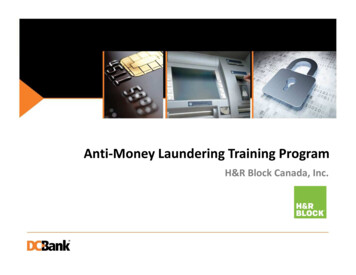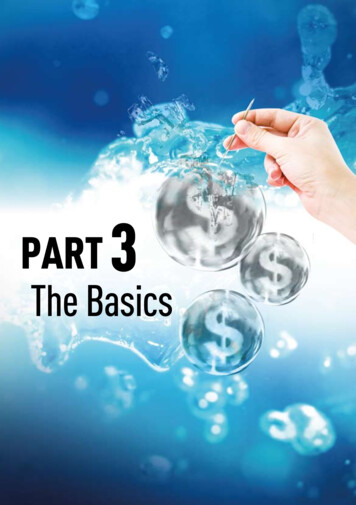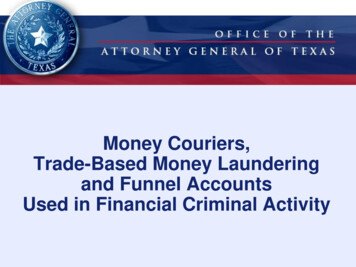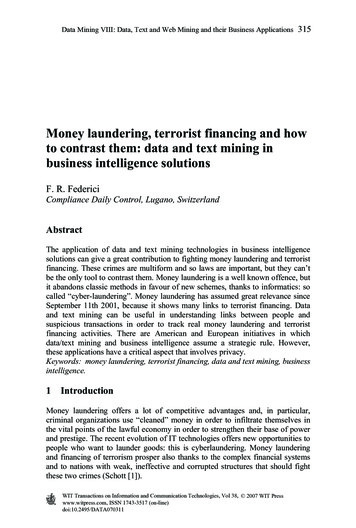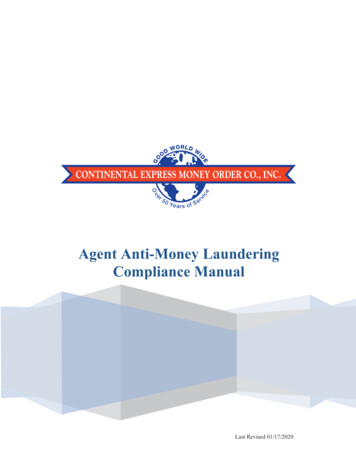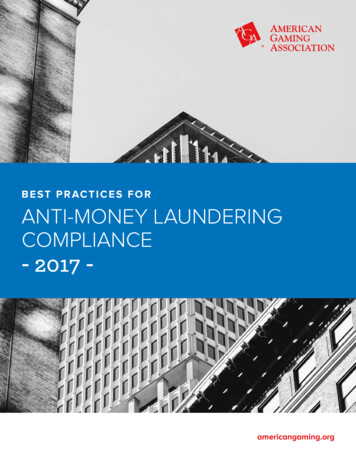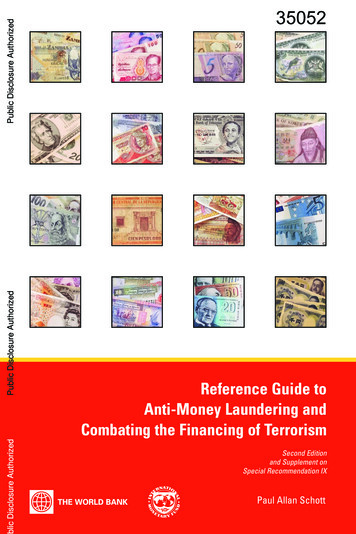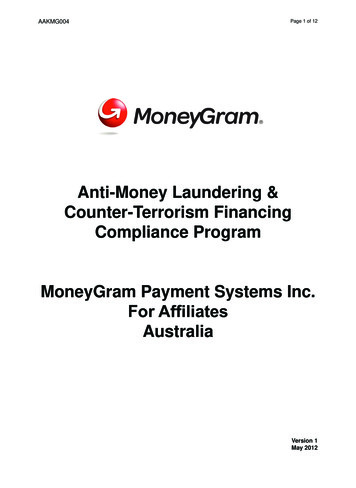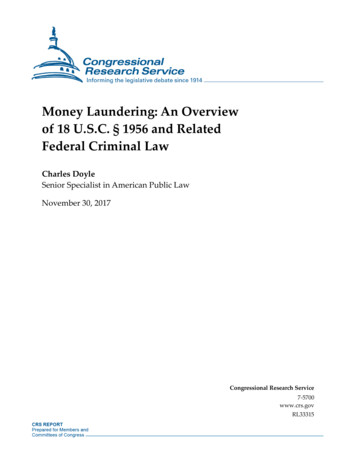
Transcription
Money Laundering: An Overviewof 18 U.S.C. § 1956 and RelatedFederal Criminal LawCharles DoyleSenior Specialist in American Public LawNovember 30, 2017Congressional Research Service7-5700www.crs.govRL33315
Money Laundering: An Overview of 18 U.S.C. § 1956 and Related Federal Criminal LawSummaryThis report provides an overview of the elements of federal criminal money laundering statutesand the sanctions imposed for their violation. The most prominent is 18 U.S.C. § 1956. Section1956 outlaws four kinds of money laundering—promotional, concealment, structuring, and taxevasion laundering of the proceeds generated by designated federal, state, and foreign underlyingcrimes (predicate offenses)—committed or attempted under one or more of three jurisdictionalconditions (i.e., laundering involving certain financial transactions, laundering involvinginternational transfers, and stings). Its companion, 18 U.S.C. § 1957, prohibits depositing orspending more than 10,000 of the proceeds from a predicate offense. Section 1956 violations arepunishable by imprisonment for not more than 20 years. Section 1957 carries a maximum penaltyof imprisonment for 10 years. Property involved in either case is subject to confiscation.Misconduct that implicates either offense may implicate other federal criminal statutes as well.Federal racketeer influenced and corrupt organization (RICO) provisions outlaw acquiring orconducting the affairs of an enterprise (whose activities affect interstate or foreign commerce)through the patterned commission of a series of underlying federal or state crimes. RICOviolations are also 20-year felonies. The Section 1956 predicate offense list automaticallyincludes every RICO predicate offense, including each “federal crime of terrorism.” A secondrelated statute, the Travel Act (18 U.S.C. § 1952), punishes interstate or foreign travel, or the useof interstate or foreign facilities, conducted with the intent to distribute the proceeds of a moremodest list of predicate offenses or to promote or carry on such offenses when an overt act iscommitted in furtherance of that intent. Such misconduct is punishable by imprisonment for notmore than five years. Other federal statutes proscribe, with varying sanctions, bulk cashsmuggling, layering bank deposits to avoid reporting requirements, failure to comply with federalanti-money laundering provisions, or conducting an unlawful money transmission business.Section 1956’s ban on attempted international transportation of tainted proceeds for the purposeof concealing their ownership, source, nature, or ultimate location is limited to instances whereconcealment is a purpose rather than an attribute of the transportation (simple smuggling is notproscribed as such), as the Supreme Court explained in Cuellar v. United States, 553 U.S. 550(2008). In a second case, the Court held that the “proceeds” of a predicate offense often referredto the profits rather than the gross receipts realized from the offense. United States v. Santos, 553U.S. 507 (2008). Congress responded by defining “proceeds” for money laundering purposes asthe property obtained or retained as a consequence of a predicate offense, including grossreceipts. P.L. 111-21, 123 Stat. 1618 (2009) (S. 386) (111th Cong.).The text of the statutes discussed, citations of state money laundering and money transmissionstatutes, and a list federal predicate offenses with their accompanying maximum terms ofimprisonment appear at the end of the report. This report appears in abridged form, withoutfootnotes, full citations, or appendixes, as CRS Report RS22401, Money Laundering: AnAbridged Overview of 18 U.S.C. § 1956 and Related Federal Criminal Law. Related CRSReports include CRS Report R44776, Anti-Money Laundering: An Overview for Congress, byRena S. Miller and Liana W. Rosen, and CRS Legal Sidebar WSLG1127, Anti-Terrorist/AntiMoney Laundering Information-Sharing by Financial Institutions Under FinCEN’s Regulations,by M. Maureen Murphy (available upon request).Congressional Research Service
Money Laundering: An Overview of 18 U.S.C. § 1956 and Related Federal Criminal LawContentsIntroduction . 118 U.S.C. § 1956 . 2Promotion . 3Financial Transactions . 3International Transmission or Transportation . 7Stings . 8Concealment . 10Financial Transactions . 10International Transportation or Transmission .11Stings . 13Evading Reporting Requirements (Smurfing). 14Financial Transactions . 15International Transportation or Transmission . 15Stings . 16Tax Evasion . 16Financial Transactions . 16Conspiracy, Attempt, Aiding and Abetting. 17Consequences . 18Imprisonment . 18Fines and Civil Penalties . 19Forfeiture . 19Venue . 2118 U.S.C. § 1957 . 21Elements . 21Conspiracy, Attempt, Aiding and Abetting. 25Consequences . 26Imprisonment . 26Fines . 26Forfeiture . 2618 U.S.C. § 1952: Travel Act . 26Distribution, Facilitation, and Violence . 28Travel, etc. . 29Unlawful Activity . 30Conspiracy, Aiding and Abetting . 31Consequences . 3131 U.S.C. § 5322: Reporting Requirements . 3231 U.S.C. § 5324: Anti-Structuring . 3331 U.S.C. § 5332: Bulk Cash Smuggling . 3518 U.S.C. § 1960: Money Transmitters . 36Racketeer Influenced and Corrupt Organizations (RICO) . 38Attachments . 40Specified Unlawful Activities (Citations to Predicate Offenses: 18 U.S.C. §§ 1956,1957)(Maximum Terms of Imprisonment Noted) . 40State Money Laundering Laws (Citations) . 45State Money Transmission Laws (Citations) . 46Congressional Research Service
Money Laundering: An Overview of 18 U.S.C. § 1956 and Related Federal Criminal LawSelected Federal Money Laundering Laws (Text) . 4618 U.S.C. § 1956. Laundering of monetary instruments . 4618 U.S.C. § 1957. Engaging in monetary transactions in property derived fromspecified unlawful activity . 51Travel Act: 18 U.S.C. § 1952. Interstate and foreign travel or transportation in aidof racketeering enterprises . 5231 U.S.C. § 5322: Reporting Requirements. 5331 U.S.C. § 5324. Structuring transactions to evade reporting requirementprohibited . 5331 U.S.C. § 5332. Bulk cash smuggling . 5418 U.S.C. § 1960. Prohibition of unlicensed money transmitting businesses. 55RICO: 18 U.S.C. § 1962. Prohibited activities . 5518 U.S.C. § 1961. Definitions . 5618 U.S.C. § 1963. Criminal penalties . 5718 U.S.C. § 1964. Civil remedies . 61ContactsAuthor Contact Information . 61Congressional Research Service
Money Laundering: An Overview of 18 U.S.C. § 1956 and Related Federal Criminal LawIntroductionMoney laundering is commonly understood as the process of cleansing the taint from theproceeds of crime.1 In federal criminal law, however, it is more. In the principal federal criminalmoney laundering statutes, 18 U.S.C. §§ 1956 and 1957, and to varying degrees in several otherfederal criminal statutes, money laundering involves the flow of resources to and from severalhundred other federal, state, and foreign crimes.2 It consists of: engaging in a financial transaction involving the proceeds of certain crimes inorder to conceal the nature, source, or ownership of proceeds they produced;3engaging in a financial transaction involving the proceeds of certain crimes inorder to promote further offenses;4transporting funds generated by certain criminal activities into, out of, or throughthe United States in order to promote further criminal activities, or to conceal thenature, source, or ownership of the criminal proceeds, or to evade reportingrequirements;5engaging in a financial transaction involving criminal proceeds in order to evadetaxes on the income produced by the illicit activity;6structuring financial transactions in order to evade reporting requirements;7spending more than 10,000 of the proceeds of certain criminal activities;8traveling in, or use of the facilities of, interstate or foreign commerce in order todistribute the proceeds of certain criminal activities;9traveling in, or use of the facilities of, interstate or foreign commerce in order topromote certain criminal activities;10transmitting the proceeds of, or funds to promote, criminal activity in the courseof a money transmitting business;111Money laundering is “the act of transferring illegally obtained money through legitimate people or accounts so that itsoriginal source cannot be traced,” Money Laundering, BLACK’S LAW DICTIONARY (10th ed. 2014).2A few years and several amendments ago, one commentator estimated the number of section 1956 predicate offensesat “250 or so,” Stefan D. Cassella, The Forfeiture of Property Involved in Money Laundering Offenses, 7 BUFF. CRIM.L. REV. 583, 612 (2004). The estimate appears exceptionally conservative. Each of the 50 states outlaws (1) murder, (2)kidnapping, (3) gambling, (4) arson, (5) robbery, (6) bribery, (7) extortion, (8) dealing in obscene material, and (9) drugdealing. A felony violation of any one of these is a section 1956 predicate offense. 18 U.S.C. §§ 1956(c)(7) (A),1961(1)(A). Each of the close to 200 countries of the world outlaws many if not most of the same types of misconduct(murder, kidnapping, robbery, and the like) and when they do, these too are section 1956 predicate offenses if theyinvolve a financial transaction in the U.S. Id. § 1956(c)(7)(B). Yet however daunting the absolute number of Section1956 predicate offenses may be, the reported cases suggest that a handful of predicate offenses (like mail fraud, wirefraud, and drug dealing) account for the vast majority of Section 1956 prosecutions.3Id. § 1956(a)(1)(B)(ii).4Id. § 1956(a)(1)(A)(i).5Id. § 1956(a)(2).6Id. § 1956(a)(1)(A)(ii).7Id. § 1956(a)(1)(B)(ii); 31 U.S.C. § 5324.818 U.S.C. § 1957.9Id. § 1952(a)(1).10Id. § 1952(a)(3).11Id. §§ 1960(a), (b)(1)(C).Congressional Research Service1
Money Laundering: An Overview of 18 U.S.C. § 1956 and Related Federal Criminal Law transmitting funds in the course of an unlawful money transmitting business;12smuggling unreported cash across a U.S. border;13 orfailing to comply with the Department of the Treasury’s anti-money launderingprovisions.14Money laundering in some forms is severely punished, sometimes more severely than theunderlying crime with which it is associated. The penalties frequently include not only longprison terms, but the confiscation of the property laundered, involved in the laundering, ortraceable to the laundering. The following is an overview of the elements and other legalattributes and consequences of a violation of Sections 1956 and 1957, as well as selected relatedfederal criminal statutes.18 U.S.C. § 1956Section 1956 outlaws four kinds of laundering—promotional, concealment, structuring, and taxevasion—committed or attempted under one or more of three jurisdictional conditions (i.e.,laundering involving certain financial transactions, laundering involving international transfers,and stings). More precisely, Section 1956(a)(1)15 outlaws financial transactions involving theproceeds of other certain crimes—predicate offenses referred to as “specified unlawful activities”(sometimes known as SUA)—committed or attempted (1) with the intent to promote furtherpredicate offenses; (2) with the intent to evade taxation; (3) knowing the transaction is designedto conceal laundering of the proceeds; or (4) knowing the transaction is designed to avoid antilaundering reporting requirements.16Section 1956(a)(2) outlaws the international transportation or transmission (or attemptedtransportation or transmission) of funds (1) with the intent to promote a predicate offense; (2)knowing that the purpose is to conceal laundering of the funds and knowing that the funds are theproceeds of a predicate offense; or (3) knowing that the purpose is to avoid reportingrequirements and knowing that the funds are the proceeds of a predicate offense.17Section 1956(a)(3) covers undercover investigations (“stings”). It outlaws financial transactions(or attempted transactions) that the defendant believes involve the proceeds of a predicate offenseand that are intended to (1) promote a predicate offense, (2) conceal the source or ownership ofthe proceeds, or (3) avoid reporting requirements.1812Id. §§ 1960(a), (b)(1)(A), (B).31 U.S.C. § 5332.14Id. § 5322. Federal law features a wide array of administrative, regulatory, and diplomatic anti-money launderingprovisions that are beyond the scope of this report.15As a matter of convenience, this report refers to subsections (18 U.S.C. § 1956(a)), paragraphs (18 U.S.C. §1956(a)(1)), subparagraphs (18 U.S.C. § 1956(a)(1)(A)), clauses (18 U.S.C. § 1956(a)(1)(A)(i)), and subclauses assections.1618 U.S.C. §§ 1956(a)(1)(A)(i), 1956(a)(1)(A)(ii), 1956(a)(1)(B)(i), and 1956(a)(1)(B)(ii), respectively.17Id. §§ 1956(a)(2)(A), 1956(a)(2)(B)(i), and 1956(a)(2)(B)(ii), respectively.18Id. §§ 1956(a)(3)(A), 1956(a)(3)(B), and 1956(a)(3)(C), respectively.13Congressional Research Service2
Money Laundering: An Overview of 18 U.S.C. § 1956 and Related Federal Criminal LawPromotionFinancial TransactionsOf the three promotional offenses, only the Section 1956(a)(1)(A)(i) financial transaction offenserequires use of the proceeds of a predicate offense to promote a predicate offense; the Section1956 international and sting offenses require only a purpose to promote a predicate offenseregardless of the source of the proceeds. Section 1956(a)(1)(A)(i) applies to anyone who:1. knowingA. that the property involved in a financial transaction,B. represents the proceeds of some form of unlawful activity,2. A. conducts orB. attempts to conductsuch a financial transaction3. which in fact involves the proceeds of specified unlawful activity4. with the intent to promote the carrying on of specified unlawful activity.19The knowledge element is the subject of a specific definition which allows a conviction withoutthe necessity of proving that the defendant knew the exact particulars of the underlying offense oreven its nature; it is enough that he knew that the property came from some sort of criminalactivity and that the property in fact constitutes the proceeds of a predicate offense.20 Theknowledge element cannot be negated by turning a blind eye to reality. Here and throughoutSection 1956, knowledge may be inferred from facts indicating that criminal activity isparticularly likely.21Throughout Section 1956, a defendant “conducts” a financial transaction when he initiates,concludes, or participates in initiating, or concluding a transaction.22 The “financial transaction”element has two obvious components. It must be a transaction and it must be financial. Both19Id. § 1956(a)(1)(A)(i); United States v. Stanford, 823 F.3d 814, 849 (5th Cir. 2016); United States v. Johnson, 821F.3d 1194, 1203 (10th Cir. 2016); United States v. Ayala-Vazquez, 751 F.3d 1, 14-5 (1st Cir. 2014); United States v.Skinner, 690 F.3d 772, 781 (6th Cir. 2012); United States v. Wilkes, 662 F.3d 524, 548 (9th Cir. 2011).20“The term ‘knowing that the property involved in a financial transaction represents the proceeds of some form ofunlawful activity’ means that the person knew the property involved in the transaction represented proceeds from someform, though not necessarily which form, of activity that constitutes a felony under State, Federal, or foreign law,regardless of whether or not such activity is specified in paragraph (7).” 18 U.S.C. § 1956(c)(1); United States v.George, 761 F.3d 42, 48 n.7 (1st Cir. 2014); United States v Flores, 454 F.3d 149, 155 (3d Cir. 2006); United States v.Hill, 167 F.3d 1055, 1065-68 (6th Cir. 1999).21United States v. Quinones, 635 F.3d 590, 594 (2d Cir. 2011) (“A conscious avoidance instruction permits a jury tofind that a defendant had culpable knowledge of a fact when the evidence shows that the defendant intentionallyavoided confirming the fact.”); see also United States v. Vinson, 852 F.3d 333, 357 (4th Cir. 2017); United States v.Haire, 806 F.3d 991, 998 (8th Cir. 2015); United States v. Adorno-Molina, 774 F.3d 116, 124-25 (1st Cir. 2014);United States v. Alaniz, 726 F.3d 586, 611-13 (5th Cir. 2013). Cf., United States v. Antzoulatos, 962 F.2d 720, 725 (7thCir. 1992) (“It is well settled that wilful blindness or conscious avoidance is the legal equivalent to knowledge.Wetherefore examine the constitutionality of section 1956(a)(1)(B) as applied to a merchant who actually knew that hewas dealing with drug dealers and their money, or deliberately turned a blind eye regarding this fact. We concludethat Antzoulatos’ right to liberty under the Fifth Amendment was not violated.”).2218 U.S.C. § 1956(c)(2). United States v. Gotti, 459 F.3d 296, 335 (2d Cir. 2006) (mere receipt of funds constitutes“conducting a financial transaction.”). In spite of the breadth of the definition, an individual must be in control at somepoint, and in some sense, of the property involved in the transaction, United States v. Huber, 404 F.3d 1047, 1060 (8thCir. 2005) (a defendant does not conduct the financial transfers of third parties which he does not initiate and in whichhe does not participate).Congressional Research Service3
Money Laundering: An Overview of 18 U.S.C. § 1956 and Related Federal Criminal Lawcomponents are defined by statute. Qualifying “transactions” may take virtually any shape thatinvolves the disposition of something constituting the proceeds of an underlying crime,23including a disposition as informal as handing cash over to someone else.24 The “financial”component supplies the jurisdiction foundation for a Section 1956(a)(1)(A)(ii) crime and each ofthe other crimes in Section 1956(a)(1). Qualifying transactions must either involve the movementof funds in a manner that affects interstate or foreign commerce or involve a financial institutionengaged in, or whose activities affect, interstate or foreign commerce.25 In either case, the effecton interstate or foreign commerce need be no more than minimal to satisfy the jurisdictionalrequirement.26The majority of Section 1956’s crimes are related in one way or another to the commission orpurported commission of at least one of a list of predicate offenses (“specified unlawfulactivities”). 27 And so it is the financial transaction promotional offense. The proscribedtransaction must involve the proceeds of a predicate offense and be designed to promote apredicate offense.28 The predicate offenses come in three varieties: state crimes, foreign crimes,and federal crimes. The list of state crimes is relatively short and consists of any state crime thatis a RICO predicate offense,29 that is, “any act or threat involving murder, kidnapping, gambling,arson, robbery, bribery, extortion, dealing in obscene matter, or dealing in a controlled substanceor listed chemical (as defined in section 102 of the Controlled Substances Act),30 which ischargeable under state law and punishable by imprisonment for more than one year.” 31The list of foreign crimes recognized as Section 1956 predicate offenses is more extensive thanthe list of state crimes, and covers among other things extraditable offenses, although crimes23“The term ‘transaction’ includes a purchase, sale, loan, pledge, gift, transfer, delivery, or other disposition, and withrespect to a financial institution includes a deposit, withdrawal, transfer between accounts, exchange of currency, loan,extension of credit, purchase or sale of any stock, bond, certificate of deposit, or other monetary instrument, use of asafe deposit box, or any other payment, transfer, or delivery by, through, or to a financial institution, by whatevermeans effected,” 18 U.S.C. § 1956(c)(3); e.g., United States v. Harris, 666 F.3d 905, 909 (5th Cir. 2012); United Statesv. Diaz-Pellegaud, 666 F.3d 492, 498 (8th Cir. 2012); United States v. Garcia, 587 F.3d 509, 516 (2d Cir. 2009).24United States v. Blair, 661 F.3d 755, 764 (4th Cir. 2011) (“Almost any exchange of money between two partiesqualifies as a financial transaction subject to criminal prosecution under §1956, provided that the transaction has atleast a minimal effect on interstate commerce and satisfies at least one of the four intent requirements”); United Statesv. Roy, 375 F.3d 21, 23-4 (1st Cir. 2004) (exchange between individuals of 100 bills for currency of smallerdenominations to facilitate drug trafficking); United States v. Gough, 152 F.3d 1172, 1173 (9th Cir. 1998); UnitedStates v. Garcia Abrego, 141 F.3d 142, 160 (5th Cir. 1998); but see Harris, 666 F.3d at 909 (“[M]ere payment of thepurchase price for drugs by whatever means does not constitute money laundering.”).25“The term ‘financial transaction’ means (A) a transaction which in any way or degree affects interstate or foreigncommerce (i) involving the movement of funds by wire or other means or (ii) involving one or more monetaryinstruments, or (iii) involving the transfer of title to any real property, vehicle, vessel, or aircraft, or (B) a transactioninvolving the use of a financial institution which is engaged in, or the activities of which affect, interstate or foreigncommerce in any way or degree,” 18 U.S.C. § 1956(c)(4).26Blair, 661 F.3d at 764; United States v. Gotti, 459 F.3d 296, 336 (2d Cir. 2006); United States v. Ables, 167 F.3d1021, 1029 (6th Cir. 1999); United States v. Owens, 167 F.3d 739, 755 (1st Cir. 1999).27Conducting or attempting to conduct an international transfer to avoid state or federal reporting requirements mustinvolve the proceeds of a crime but the property-generating offense need not be a money laundering predicate,18 U.S.C. § 1956(a)(2)(B)(ii).28Id. § 1956(a)(1)(A)(i).29Id. § 1956(c)(7)(A).3021 U.S.C. §§ 802(6) and 802(33), respectively.3118 U.S.C. § 1961(1)(A).Congressional Research Service4
Money Laundering: An Overview of 18 U.S.C. § 1956 and Related Federal Criminal Lawunder the laws of other countries qualify as predicate offenses only if the financial transactionoccurs in this country in whole or in part.32The list of federal predicate offenses is considerably longer if for no other reason than that thesome qualifying offenses are specifically named and others qualify by cross-reference to thevoluminous RICO predicate offense list.33 The crimes listed by name as predicates includeoffenses such as interstate kidnapping, theft of funds from federally supported programs, andbank robbery.34 RICO predicates also name bribery, mail fraud, and wire fraud as predicates.35Moreover, the RICO predicate offense list encompasses by cross-reference the federal crimes ofterrorism cataloged in 18 U.S.C. § 2333b(g)(5)(B).36As for the promotional element, some of the lower courts have concluded that it “may be met bytransactions that promote the continued prosperity of the underlying offense.”37 One circuit hasdeclared, however, that “the ‘promotion’ element of money laundering promotion cannot be metsimply by demonstrating that the unlawfully earned monies were used to promote the continuedfunctioning of an ‘otherwise legitimate business enterprise.’ For instance, paying the bills3218 U.S.C. § 1956(c)(7)(B) (“[T]he term ‘specified unlawful activity’ means (B) with respect to a financialtransaction occurring in whole or in part in the United States, an offense against a foreign nation involving - (i) themanufacture, importation, sale, or distribution of a controlled substance (as such term is defined for the purposes of theControlled Substances Act); (ii) murder, kidnapping, robbery, extortion, destruction of property by means of explosiveor fire, or a crime of violence (as defined in section 16); (iii) fraud, or any scheme or attempt to defraud, by or against aforeign bank (as defined in paragraph 7 of section 1(b) of the International Banking Act of 1978)); (iv) bribery of apublic official, or the misappropriation, theft, or embezzlement of public funds by or for the benefit of a public official;(v) smuggling or export control violations involving - (I) an item controlled on the United States Munitions Listestablished under section 38 of the Arms Export Control Act (22 U.S.C. 2778); or (II) an item controlled underregulations under the Export Administration Regulations (15 C.F.R. Parts 730–774); (vi) an offense with respect towhich the United States would be obligated by a multilateral treaty, either to extradite the alleged offender or to submitthe case for prosecution, if the offender were found within the territory of the United States; or (vii) trafficking inpersons, selling or buying of children, sexual exploitation of childr
1 Money laundering is "the act of transferring illegally obtained money through legitimate people or accounts so that its original source cannot be traced," Money Laundering, BLACK'S LAW DICTIONARY (10th ed. 2014). 2 A few years and several amendments ago, one commentator estimated the number of section 1956 predicate offenses
